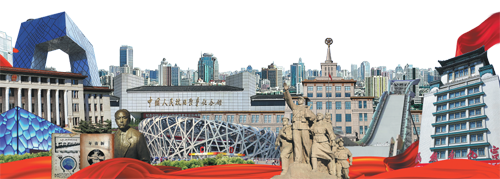
Driving along Chang'an Avenue in Beijing, visitors quickly realize that the area is China's political center, especially as the many towering buildings help to create such an atmosphere.
As a major global manufacturer, China is proud of the quality and efficiency of its infrastructure construction.
And it proved that as early as the 1950s, when 10 major architectural projects in the capital-including the Great Hall of the People, the National Museum of China, the Diaoyutai State Guesthouse, the Beijing Workers' Stadium and the Beijing Railway Station-were all built during a 10-month period.
In August 1958-ahead of celebrations to mark the 10th anniversary of the founding of the People's Republic of China in October 1959-the central government decided on a series of public construction projects in the capital.
The buildings were intended to meet the needs of the country's political, diplomatic and international exchanges and better serve local people's cultural and social lives. They were named Beijing's "10 monumental buildings".
Other famous buildings-the UN Headquarters in New York, the Palace of Nations in Geneva and Sydney Opera House-took between six and 10 years to build on average.
That's why the 10 buildings in Beijing, covering a total area of more than 670,000 square meters, were seen as a miracle in global architectural history and showed the intelligence, creativity and hard work of the Chinese people, experts said.
Back then, China had not constructed a building higher than 10 stories, and the use of machinery was limited.
However, the architects, designers and workers found a way. Now, the Great Hall of the People hosts China's most important political events, the Diaoyutai State Guesthouse has welcomed thousands of foreign leaders, and the National Museum of China collects and displays numerous artistic masterpieces and historical relics.
Most of the 10 buildings have become must-see landmarks for tourists and have served the people over the past six decades.
"Why is architecture so important? Because it shows the characteristics of an era and the confidence of a country. The 10 buildings expressed New China's capacity in politics, technology and culture, and the idea to promote a people-centered development model," said Xu Quansheng, chairman of the Beijing Institute of Architectural Design, speaking in March.
Sharing stories
People who participated in the construction of the buildings were invited to share their stories as part of Beijing's celebrations to mark the 100th anniversary of the founding of the Communist Party of China.
Li Guosheng, 88, former deputy director of the institute's No 2 design branch, said the most difficult construction project was the Great Hall of the People, in which 10,000 people can hold meetings at the same time.
Initially, the design covered 70,000 sq m, but to add more functionality, the final area was expanded to more than 170,000 sq m.
Exacerbating the difficulties was the fact that there was no previous model to refer to when building such a large hall with many complex functions, Li said.
Construction began in October 1958 and ended in July 1959 so the building could be prepared for an important event on Sept 30, when representatives of 83 countries would be invited, he added.
"To meet the tight schedule, we designers had to work overtime to make design drawings. After staying up and working for two nights, I could barely remember where I should get off my bus," he said.
About 300,000 workers helped construct the hall, while around 200 companies from 23 provinces produced equipment and building materials, China News Service reported.
The project was conducted in a spirit of coordination, and its success was an achievement of socialism, experts said.
Ma Guoxin, a third grade high school student in Beijing at the time, worked at the construction site as a volunteer with some classmates.
He later studied architecture at university and was one of the architects who helped design the National Olympic Sports Center, the Chairman Mao Zedong Memorial Hall and Terminal 2 of the Beijing Capital International Airport.
"I think the 10 projects brought people closer. Under the CPC's leadership, the construction succeeded and received great public recognition," he said. He recalled that in addition to experts, college students were also invited to share their opinions, such as which color should be used for the hall's exterior finish.
"It showed the Party's practical and realistic working style, as well as its implementation of the 'mass line' (that respected the opinions of ordinary people)."
Shao Weiping, chief architect of the Beijing Institute of Architectural Design, said the National Agricultural Exhibition Center was intended to showcase China's agricultural industry, while the Military Museum of the Chinese People's Revolution memorialized military achievements.
The Cultural Palace of Nationalities displayed the cultural and social lives of people from different ethnic groups, and the Beijing Workers' Stadium, which could initially house 80,000 people, was built to host the first National Games of the PRC and was the nation's first major sports stadium.
Meanwhile, the Diaoyutai State Guesthouse, located in a Qing Dynasty (1644-1911) royal garden, was renovated as a national-level reception site in a traditional style.
From 1949 to 1959, newly constructed buildings covered 27.24 million sq m in Beijing, 1.3 times the area of the city's original buildings.
Now, the total construction area has reached 1.75 billion sq m, close to the maximum limit of 2.1 billion sq m, Xu said.
Following the milestone 10 buildings, more renowned constructions appeared, such as the Beijing National Stadium, also known as the Bird's Nest, the National Center for the Performing Arts, the Beijing Daxing International Airport and brand-new stadiums for the 2022 Beijing Winter Olympic Games.
According to the overall plan for Beijing's development from 2016 to 2035, the city landscape should be a combination of traditional culture and modern civilization.
It said the cultural connotations of the architecture should be emphasized, and buildings should blend in with the surrounding environment.
In addition, high-quality buildings that will illustrate the city's history, spirit and style have been heavily encouraged.

